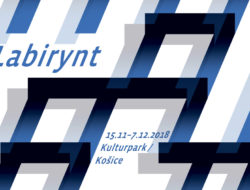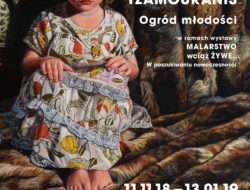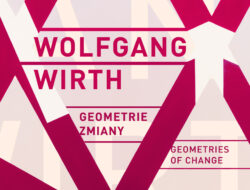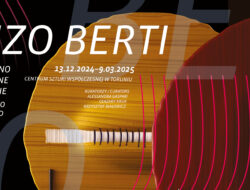When: 11.11.2018–13.01.2019
Opening: 11 November (Sunday), at 6.30 PM
Curators: Marek Żydowicz, Michael Haas
The exhibition is part of the exposition titled Painting still alive.
Exhibition Production: Wojciech Ruminski
At the exhibition of Joachim Elzmann’s work, we will present a few cycles of paintings and spatial forms – sculptures and reliefs – which were created in the aftermath of the artist’s visual impressions from his everyday walks and journeys around the city. Elzmann uses electronic devices to record fragments of the reality he finds interesting. The recorded content is then freely processed in the artist’s imagination and thus becomes an inspiration for creating abstract forms.
Elzmann’s works are created mostly as a result of his playing with the material. The artist uses simple materials of low value, mainly cardboard, but also wood, wire, styrofoam or plaster; sometimes he prepares a bronze cast of the works created with simple materials, but he paints his work anew so that the final result reflects the physical features of the original material rather than bronze. The materials used and most of all the way of using them refer to the 1920s, when first collages were created. The main reference is the art of Kurt Schwitters. That artist’s spirit can be traced in Elzmann’s playful combinations of collage and assemblage, in the pleasure he finds in experimenting and discovering new meanings; the motif of playfulness refers not only to the process of creation, though – in the past, the artist used games and game accessories, such as playing cards or Mikado sticks, to build his installations.
The motif of game and play, and more precisely, the playing field, will also be visible in the works presented in Toruń, e.g. in such pieces as: Restautomat I and II or Vierrest.
Another motif we will find in the works presented at the exhibition is the structural element that orders the structure of open collage and assemblage, visible in such pieces as Rotund, Tower, Church. The works refer to the same period in the history of art as the collages, and the inspiration behind them are the masterpieces by Tatlin, El Lissitzky, Nikolaus Pevsner or Naum Gabo. The works also feature cities as their central element – this motif can be found in the sculptures, bas-reliefs, collages, assemblages and paintings. The inspiration is often indicated in the titles of the works, e.g.: Venice, Düsseldorf, Image of the city / Berlin. These are not specific portrayals of the cities, though, nor are they illustrations of their characteristic features. It is more about loose associations, about the mood and atmosphere of the paintings that create a balance between the artistic material, the process of creation and any possible subject matter. Elzmann outlines a broad scope of urban structures and expands the notion of the genuine essence of a city. His paintings both reflect architectural and urban structures, and present human civilisation in a simple manner, with all the variety of its origins, characters and ideas. The artist looks not only at a city as a whole, but also at individual objects and building types, which have specific functions in urban social networks, e.g.: Hospital, Church, Rotund, Tower.
Elzmann’s art combines sculpture, bas-relief, collage, painting and drawing, it merges construction with deconstruction, and history with direct coexistence of art. This is how his work is again evocative of Kurt Szchwitters, who perceived art and everyday life as inextricably entwined elements that centred in the heart of play and art rather than two opposites.
At the exhibition we will have an opportunity to see 45 works: paintings created with the use of mixed techniques, sculptures and installations. The presented works were created in 2007–2018, so they reflect the artist’s latest accomplishments.
The text above is based on the text by Reinhard Spieler In the playing field of art and life, which will form part of the exhibition catalogue.
Tags: camerimage, exhibition
 The Institution is funded from the budget of Toruń Municipality
The Institution is funded from the budget of Toruń Municipality






